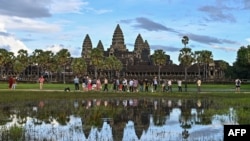Cambodia is still struggling to fulfill its ambitious goal of becoming a Chinese tourist hub, building on its pre-pandemic reputation as an attractive destination.
Last month, it opened a new China-funded airport not far from the ancient Angkor Wat temple complex in Siem Reap, a UNESCO World Heritage site.
This came after the 2016 rollout of a "China Ready" tourism strategy, aimed at equipping tour guides with Chinese language skills, providing signs and travel documents in Chinese, and making sure food and facilities meet Chinese tastes.
But in a post-pandemic world, Chinese tourists have been slow to return, and so far this year, the number of Chinese visitors is just one-third of pre-pandemic arrivals.
Prime Minister Hun Manet projected optimism during a speech at the inauguration of the new Siem Reap Angkor International Airport, saying that he and Chinese President Xi Jinping had declared 2024 "a year of people-to-people exchanges" during a meeting in Beijing in October.
In the first 10 months of 2023, Cambodia received about 450,000 Chinese tourists, according to Cambodia's Tourism Ministry. The tally is expected to reach about 700,000 by year's end, boosted by a surge during the cooler months of November and December.
That's down from a record 2.3 million visitors from China in 2019, though it's a big improvement over the COVID-19 pandemic years. Just 90,000 Chinese tourists visited Cambodia in 2022, according to ministry figures.
Several factors seem to be working against Cambodia's aspirations.
China's post-pandemic economy remains sluggish. This has prompted people to opt out of more expensive international travel, according to FDIntelligence, which found international trips are down because of cost, visa backlogs, a lack of international flights and fears about personal safety.
Yet those in Cambodia reliant on Chinese tourists are encouraged by this year's slight but noticeable upward trend.
"Because this new airport is capable of handling large aircraft, we can get more flights to new destinations," said Chhay Sivlin, president of the Cambodian Tourism Association. "Thus, we have high expectations for the increase in arrivals as well as tourists from all over."
Tea Kileng, president of the Cambodian Chinese Tourist Association, said the new airport would allow the Cambodian government to promote flights from provinces across China.
"I believe that the number of Chinese tourists will increase," he said, adding that their return is important for travel agencies, hotels and restaurants, along with car and tuk-tuk drivers.
Tea Kileng, who is also a Chinese-language tour guide, said he earned about $50 a day or more before COVID-19 decimated the travel industry. These days, he often earns nothing.
The signs are rosier for tourism overall. Cambodia has received about 4.4 million international tourists so far this year, up from 1.9 million during the same stretch last year, and expects to receive up to 5.4 million by the end of 2023, according to a senior Tourism Ministry official. That would still be down from about 6.6 million in 2019.
Khieu Thy, president of the Angkor Tour Guide Association, said the nationality of tourists makes a difference for local operators. He said Chinese travelers tend to buy all-inclusive packages that include flights, accommodation and food — but they also spend generously on souvenirs and other local products.
"Chinese people like to buy a lot of souvenirs. They like to buy things that Cambodians have — such as trinkets, palm sugar, cashew nuts, dried fish, smoked fish, Cambodian sausages, soy sauce, chili sauces — and this is very helpful to our local economy," he said.
According to a September report from Nikkei Asia, regional tourism experts told the outlet that many travelers were canceling plans to visit Southeast Asia after warnings from police and other officials about kidnappings.
Fear of being becoming a victim of human trafficking even inspired a Chinese blockbuster called "No More Bets," in which characters wear T-shirts with Khmer writing in an unnamed Southeast Asian nation where human trafficking rings operate.
Cambodian government spokesperson Pen Bona dismissed the film's fear factor, noting that movies often depict terrible things happening in faraway places without triggering a precipitous drop in visitors. Cambodia remains a safe destination and tourists rarely encounter problems, he said.
Chhay Sivlin, of the tourism association, suggested the government should provide more digital outreach to the Chinese people and emphasize measures it is taking to ensure the safety of all tourists. "We have to get back to life as soon as possible."







